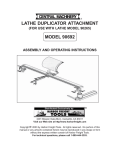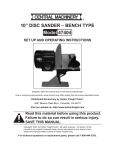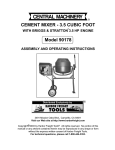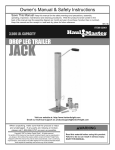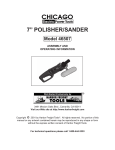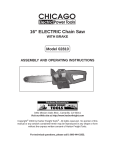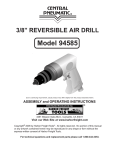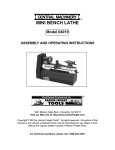Download Central Hydraulics Life Jacket 91020 User's Manual
Transcript
R TRANSMISSION JACK 1200 LBS. CAPACITY - LOW PROFILE MODEL 91020 OPERATING INSTRUCTIONS ® 3491 Mission Oaks Blvd., Camarillo, CA 93011 Visit our Web site at http//www.harborfreight.com Copyright© 2003 by Harbor Freight Tools®. All rights reserved. No portion of this manual or any artwork contained herein may be reproduced in any shape or form without the express written consent of Harbor Freight Tools. For technical questions, please call 1-800-444-3353. PRODUCT SPECIFICATIONS Item Maximum Lifting Capacity Overall Dimensions Front & Rear Castors Saddle Block Dimensions Saddle Side To Side Tilt Saddle Forward Tilt Pump Lever Rotation Lift Range Chain Dimensions Jack Handle Dimensions Release Method Weight Description 1,200 Pounds. 18-1/2” W x 38” L x 32” H (Fully Raised). 18-1/2” W x 38” L x 8” H (Fully Lowered). Quantity: 4 / Dimensions: 1-1/4” W x 4” H. 9-1/8” W x 9-1/8” L. 12°. 65°. 360°. 5-3/4” (Minimum). 31-1/2” (Maximum). 1/4” Thick x 39” Long. 7/8” Diameter x 24” Long. Twist Valve Type. 116 Pounds. SAVE THIS MANUAL You will need this manual for the safety warnings and precautions, assembly, operating, inspection, maintenance and cleaning procedures, parts list and assembly diagram. Keep your invoice with this manual. Write the invoice number on the inside of the front cover. Keep this manual and invoice in a safe and dry place for future reference. UNPACKING When unpacking, check to make sure all the parts shown in the Parts List on page 10 are included. If any parts are missing or broken, please call Harbor Freight Tools at the number shown on the cover of this manual as soon as possible. GENERAL SAFETY WARNINGS AND PRECAUTIONS 1. Keep work area clean and dry. Cluttered, damp, or wet work areas invite injuries. 2. Keep children away from work area. Do not allow children to handle this product. SKU 91020 PAGE 2 3. Store idle equipment. When not in use, tools and equipment should be stored in a dry location to inhibit rust. Always lock up tools and equipment, and keep out of reach of children. 4. Do not use this product if under the influence of alcohol or drugs. Read warning labels on prescriptions to determine if your judgement or reflexes are impaired while taking drugs. If there is any doubt, do not attempt to use this product. 5. Use eye and hand protection. Wear ANSI approved safety impact eye goggles, and safety gloves when using this product. ANSI approved safety impact eye goggles and safety gloves are available from Harbor Freight Tools. 6. Dress safely. Do not wear loose clothing or jewelry, as they can become caught in moving parts. Wear a protective hair covering to prevent long hair from becoming caught in moving parts. 7. Do not overreach. Keep proper footing and balance at all times to prevent tripping, falling, back injury, etcetera. 8. Industrial applications must follow OSHA requirements. 9. Stay alert. Watch what you are doing at all times. Use common sense. Do not use this product when you are tired or distracted from the job at hand. 10. Check for damaged parts. Before using this product, carefully check that it will operate properly and perform its intended function. Check for damaged parts and any other conditions that may affect the operation of this product. Replace or repair damaged or worn parts immediately. 11. Replacement parts and accessories: When servicing, use only identical replacement parts. Only use accessories intended for use with this product. Approved accessories are available from Harbor Freight Tools. 12. Maintain this product with care. Keep this product clean and dry during storage for better and safer performance. For your safety, service and maintenance should be performed regularly by a qualified technician. 13. Use the right equipment for the job. Do not attempt to force small equipment to do the work of larger industrial equipment. There are certain applications for which this equipment was designed. It will do the job better and more safely at the rate for which it was intended. Do not modify this equipment, and do not use this equipment for a purpose for which it was not intended. 14. WARNING! The warnings, precautions, and instructions discussed in this manual SKU 91020 PAGE 3 cannot cover all possible conditions and situations that may occur. The operator must understand that common sense and caution are factors, which cannot be built into this product, but must be supplied by the operator. SPECIFIC PRODUCT WARNINGS AND PRECAUTIONS 1. Do not exceed the maximum lift capacity (1200 pounds) for the Transmission Jack. Overloading the Transmission Jack could cause personal injury and/or property damage. 2. Use of the Transmission Jack is limited to the removal, installation, and transportation (in the Jack’s lowered position) of transmissions and differentials within the weight limitation specified. No alteration to the Jack or adapters shall be made. 3. Never open or adjust the Bypass Valve. (Noted in Figure A, page 6.) The Bypass Valve is an essential safety device that is factory-set. Adjusting the Bypass Valve may cause serious personal injury, property damage, or hinder proper operation of the Transmission Jack. 4. Make sure the Transmission Jack is used only on a dry, oil/grease free, solid, level, concrete surface capable of supporting the weight of the entire vehicle, Transmission Jack, and any additional tools and equipment. 5. Prior to using the Transmission Jack, make sure to read and understand all warnings, safety precautions, and instructions as outlined in the vehicle manufacturer’s instruction manual. 6. Do not use the Transmission Jack with the vehicle’s engine running. Also, make sure to place proper support devices (not included) under the vehicle. 7. Do not allow anyone in the vehicle while using the Transmission Jack. Keep all bystanders a safe distance away from the vehicle. 8. Never leave the Transmission Jack unattended when the Jack is under a load. 9. Always keep hands, fingers, and feet away from the moving parts of the Transmission Jack when applying or releasing a load. Remain clear of the Transmission Jack when raising or lowering a transmission or differential. 10. Always evaluate your task before using the Transmission Jack. The Transmission Jack is designed to support a transmission or differential as individual components. Assemblies such as a differential with an axle, or a transmission with bell housing, can be bulky and difficult to balance on the Jack’s platform or cradle. SKU 91020 PAGE 4 Lifting such assemblies, even within the weight limit, can create an o f f - b a l a n c e situation, causing the Transmission Jack to tip over and lead to serious personal injury and/or property damage. The load should be evenly distributed on the Transmission Jack, and should not extend beyond the area of the caster wheelbase. Always use safety straps and/or chains to secure the load. 11. If you are working and the load becomes off-balanced and/or the Transmission Jack begins to tip over, DO NOT attempt to catch or lift the Jack when it is falling. In this event, clear the area as quickly and safely as possible in order to avoid injury from the falling load or getting hit with flying fragments. 12. If in doubt about the safety of your project, it is recommended that you have the work done by a qualified technician familiar with applicable safe practices. Do not use the Transmission Jack as a permanent stand for a transmission or differential. Use the Transmission Jack only while making repairs. Then, immediately remove the transmission or differential from the Transmission Jack. 13. 14. Before lowering the Transmission Jack, make sure tools, tool trays, vehicle parts, and all other equipment are removed from under the Jack. 15. Maintain labels and nameplates on the Transmission Jack. These carry important information. If unreadable or missing, contact Harbor Freight Tools for a replacement. ASSEMBLY AND OPERATING INSTRUCTIONS NOTE: For additional references to the parts listed in the following pages, refer to the Assembly Diagram on page 11. To Assemble The Handle: 1. Prior to operation, the Handle (36) must be attached to the Transmission Jack. To do so, loosen the Hex Cap Screw (44) that is located on the Handle Socket (46). Insert the open end of the Handle fully into the Handle Socket. Then, firmly retighten the Hex Cap Screw. (See Figure A, next page.) To Purge The Hydraulic System Of Excess Air: 1. IMPORTANT! Make sure to thoroughly test the Transmission Jack for proper operation prior to its actual use. If the Transmission Jack appears SKU 91020 PAGE 5 not to be working properly, it may be necessary to purge its hydraulic system of excess air. To do so, remove the Filler Plug (45). Turn the Release Valve (47) counterclockwise to its open position. Pump the Handle rapidly numerous times. The trapped air is pressurized and will be audible when released in this manner. Once purged of air, check the Oil Chamber and, if necessary, top off the Oil Chamber with hydraulic oil. Then replace the Filler Plug, and turn the Release Valve clockwise to its closed position. Pump the Handle several times, using full, smooth strokes. The Transmission Jack should now operate properly. If, after purging, the Hydraulic Jack still does not appear to be working properly, do not use the Hydraulic Jack until it has been repaired by a qualified technician. (See Figure A.) To Lower A Transmission Onto The Transmission Jack: 1. IMPORTANT! When raising a vehicle, make sure to use a commercial grade lift or jack fully capable of supporting the weight of the vehicle. Also, read and understand all safety warnings and precautions as outlined in the manufacturer’s manual for the lift or jack. GREASE FITTING (33) HANDLE SOCKET (46) HEX CAP SCREW (44) FILLER PLUG (45) HANDLE (36) BYPASS VALVE (DO NOT ADJUST) RELEASE RELEASE VALVE CHECK VALVE (47) FIGURE A SKU 91020 PAGE 6 2. WARNING! Do not use the Transmission Jack with the vehicle’s engine running. Make sure to set the emergency brake, use adequate vehicle support stands if needed, and block the tires opposite the tire(s) being lifted. 3. Once the vehicle is raised and secured, clear the area underneath the vehicle of people and tools. Then, wheel the Transmission Jack under the transmission. 4. To raise the Saddle Assembly (12) of the Transmission Jack, turn the Release Valve (47) clockwise to its closed position. Pump the Handle, using full, smooth strokes. (See Figure A.) 5. Stop just below the transmission, and level the Saddle Assembly (12) with the Forward Adjusting Knob (24) and Side Adjusting Knob (6). Turning the Forward Adjusting Knob clockwise will lift the front of the Saddle Assembly upward, and turning it counterclockwise will return the Saddle Assembly to a level position. Turning the Side Adjusting Knob clockwise will tilt the Saddle Assembly up, raising the left side. Turning it counterclockwise will bring the Saddle Assembly back to level. (See Figure B.) HEX BOLT (14) FINGER (16) SADDLE ASSEMBLY (12) SIDE ADJUSTING KNOB (6) FORWARD ADJUSTING KNOB (24) FIGURE B 6. Continue raising the Saddle Assembly (12) up to the transmission to determine where you will need to adjust the four Fingers (16). All four Fingers need to grip and make contact with the transmission. (See Figure B.) 7. After determining where the four Fingers (16) need to be set, loosen the Hex Bolt (14) on each Finger and adjust the Fingers to the proper setting for the transmission. Then, retighten the Hex Bolts. (See Figure B.) 8. Secure the Chain (13) to the Chain Bracket, and wrap the Chain securely around the transmission. Attach the other end of the Chain to the Hook (17) on the other side of the Saddle Assembly (12). Then, tighten the Wing Nut (20) on the other end of the Hook. (See Figure C, next page.) SKU 91020 PAGE 7 SADDLE ASSEMBLY (12) CONNECT CHAIN HERE. HOOK (17) WING NUT (20) (NOT SHOWN) CONNECT CHAIN TO CHAIN BRACKET FIGURE C 9. Once you are sure the transmission is secured by the Chain (13), remove the bolts and other hardware holding the transmission to the chassis. 10. Make sure the area is clear of people and tools, and verify that the transmission is securely held in place by the Transmission Jack. Then, slowly turn the Release Valve (47) counterclockwise to lower the Transmission Jack to its lowest position before moving the unit. (See Figure A.) 11. Carefully wheel the Transmission Jack from under the vehicle to perform the desired maintenance on the transmission. To Raise The Transmission Back Into Place: 1. After performing the maintenance on the transmission, move the Transmission Jack under the vehicle so that the transmission is lined up properly with its connection points. 2. To raise the transmission, turn the Release Valve (47) clockwise to its closed position. Pump the Handle, using full, smooth strokes. (See Figure A.) 3. Guide the transmission into place, and replace the bolts and other hardware to secure the transmission to the chassis. Double check to make sure the transmission is securely installed. SKU 91020 PAGE 8 4. Loosen the Wing Nut (20) on the Hook (17) to remove one side of the Chain (13). Move the Chain out of the way, making sure it will not be in the way of the Transmission Jack when it lowers. (See Figure C.) 5. Make sure nobody is close to the Transmission Jack. Slowly turn the Release Valve (47) counterclockwise to lower the Transmission Jack to its lowest position. Then, wheel the Transmission Jack clear of the vehicle. (See Figure A.) INSPECTION, MAINTENANCE, AND CLEANING 1. Before each use, inspect the general condition of the Transmission Jack. Check for broken or bent parts, loose or missing parts, and any condition that may affect the proper operation of the product. If a problem occurs, have the problem corrected before further use. Do not use damaged equipment. 2. Keep all moving parts of the Transmission Jack well lubricated. Periodically, lubricate the Grease Fitting (33). (See Figure A.) 3. Change the hydraulic oil at least once every three years. To do so, with the Transmission Jack fully collapsed remove the Oil Filler Plug (45) at the top of the Oil Reservoir. Tip the Transmission Jack to allow the old oil to drain out of the Reservoir completely, and dispose of the old oil in accordance with local hazardous waste authority regulations. With Transmission Jack upright, completely fill the reservoir with a high quality hydraulic oil (not included). Then, reinstall the Oil Filler Plug. Make sure to thoroughly test the Transmission Jack for proper operation prior to its actual use. If the Transmission Jack appears not to be working properly, it may be necessary to purge its hydraulic system of excess air. (See instructions on page 5 and Figure A.) 4. Purge the hydraulic system of air occasionally. Occasionally, the Transmission Jack will exhibit signs of excessive air in its hydraulic system such as slow response to pumping, a spongy feeling to the pumping operation, and a general lack of performance. To purge the hydraulic system of air, open the Release Valve (never more than two turns). Loosen the Oil Filler Plug (45) just enough for any air to escape. Then, re-tighten the Release Valve, and slowly pump the Transmission Jack several times. The trapped air is pressurized and will be audible when released in this manner. Once purged of air, check the Oil Reservoir and, if necessary, top off the Reservoir with hydraulic oil. Then, replace the Oil Filler Plug, and completely lower the Transmission Jack. Make sure to thoroughly test the Transmission Jack for proper operation prior to its actual use. (See Figure A.) SKU 91020 PAGE 9 PLEASE READ THE FOLLOWING CAREFULLY THE MANUFACTURER AND/OR DISTRIBUTOR HAS PROVIDED THE PARTS LIST AND ASSEMBLY DIAGRAM IN THIS MANUAL AS A REFERENCE TOOL ONLY. NEITHER THE MANUFACTURER OR DISTRIBUTOR MAKES ANY REPRESENTATION OR WARRANTY OF ANY KIND TO THE BUYER THAT HE OR SHE IS QUALIFIED TO MAKE ANY REPAIRS TO THE PRODUCT, OR THAT HE OR SHE IS QUALIFIED TO REPLACE ANY PARTS OF THE PRODUCT. IN FACT, THE MANUFACTURER AND/OR DISTRIBUTOR EXPRESSLY STATES THAT ALL REPAIRS AND PARTS REPLACEMENTS SHOULD BE UNDERTAKEN BY CERTIFIED AND LICENSED TECHNICIANS, AND NOT BY THE BUYER. THE BUYER ASSUMES ALL RISK AND LIABILITY ARISING OUT OF HIS OR HER REPAIRS TO THE ORIGINAL PRODUCT OR REPLACEMENT PARTS THERETO, OR ARISING OUT OF HIS OR HER INSTALLATION OF REPLACEMENT PARTS THERETO. PARTS LIST Part # 1 2 3 4 5 6 7 8 9 10 11 12 13 14 15 16 17 18 19 20 21 22 23 24 Description Main Frame Lift Arm Lift Arm Strap Front Link Snap Ring Side Adjuster Knob Spacer Side Pivot (Front) Hex Nut Side Pivot (Back) Snap Ring Saddle Assembly Chain/Bolt Kit Hex Bolt Washer Finger Hook Stud Washer Wing Nut Hex Nut Side Pivot Shaft Saddle Support Assembly Forward Adjuster Knob Qty. 1 1 2 2 8 1 1 1 2 1 4 1 1 8 8 4 1 1 2 1 1 1 1 1 Part # 25 26 27 28 29 30 31 32 33 34 35 36 37 38 39 40 41 42 43 44 45 46 47 Description Spring Pin Forward Pivot (Front) Bearing Forward Pivot (Back) Channel Nut Cotter Pin Forward Pivot (Shaft) Return Spring Grease Fitting Cotter Pin Hydraulic Unit Handle Lock Washer Hex Cap Screw Lift Arm Pivot Pin Hex Cap Screw Caster Washer Lock Nut Hex Cap Screw Filler Plug Handle Socket Release Valve Qty. 2 1 1 1 1 1 1 1 1 1 1 1 4 4 1 16 4 16 16 1 1 1 1 NOTE: Some parts are listed and shown for illustration purposes only, and are not available individually as replacement parts. SKU 91020 PAGE 10 ASSEMBLY DIAGRAM 46 45 . 47 NOTE: Some parts are listed and shown for illustration purposes only, and are not available individually as replacement parts. SKU 91020 PAGE 11











